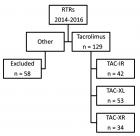Abstract
Review Article
An educational strategy for the implementation of a delirium assessment tool
Beatriz Bonaga*, Elena Ruiz-Escribano Taravilla, Carmen Carrilero-López, María Dolores Castillo-Lag, Leanne M Boehm, Ángela Prado Mira, María Joaquina Piqueras Diaz and E Wesley Ely
Published: 10 August, 2021 | Volume 6 - Issue 1 | Pages: 015-020
Background: Delirium is an acute syndrome of organ dysfunction with long-term consequences which commonly occurs in the Intensive Care Unit (ICU). The incidence of delirium ranges from 30% - 50% in low severity ICU patients and up to 80% in mechanically ventilated patients. This condition is frequently under-recognized and daily routine screening is a key strategy to early intervention. The Confusion Assessment Method for the Intensive Care Unit (CAM-ICU) and the Intensive Care Delirium Screening Checklist (ICDSC) are the most recommended assessment tools for detecting delirium in the critical ill patient.
Objective: The main objective of this study is to educate ICU staff about delirium. In addition, nurses were trained to use the CAM-ICU as a standard screening tool. The intervention was evaluated through a survey aimed at ICU staff.
Methods: An educational intervention was started in 2014 in our ICU. An educational package for ICU staff consisted of a didactic brochure and explanatory videos. One-on-one teaching, case based scenarios and didactic teaching were strategies used in the implementation process. The entire intervention was evaluated by means of a survey directed to the professionals.
Results: The structure of the didactic brochure was simple in order to have an easy understanding of the CAM-ICU tool. We also created 10-minute videos. According to the results of the satisfaction survey (N=62), disorganized thinking was the most difficult feature of CAM-ICU to interpret. When in doubt, consultation between co-workers was the primary resource selected by unit staff.
Conclusion: This initiative achieved the objective of training health care professionals in the application of the CAM-ICU tool with a good level of satisfaction from them. Therefore, ICU staff consider delirium management in the broader picture of critically ill patient care as a major activity of daily practice.
Read Full Article HTML DOI: 10.29328/journal.jcicm.1001035 Cite this Article Read Full Article PDF
References
- Brummel NE, Girard TD. Preventing delirium in the intensive care unit. Crit Care Clin. 2013; 29: 51-65. PubMed: https://pubmed.ncbi.nlm.nih.gov/23182527/
- Van Rompaey B, Elseviers MM, Schuurmans MJ, Shortridge – Baggett LM, Truijen S, et al. Risks factors for delirium in intensive care patients: a prospective cohort study. Crit Care. 2009; 13: R77. PubMed: https://pubmed.ncbi.nlm.nih.gov/19457226/
- Thomason JW, Shintani A, Peterson JF, Pun BT, Jackson JC, et al. Intensive care unit delirium is an independent predictor of longer hospital stay: a prospective analysis of 261 non-ventilated patients. Crit Care. 2005; 9: 375-381. PubMed: https://pubmed.ncbi.nlm.nih.gov/16137350/
- Salluh JI, Soares M, Teles JM, Ceraso D, Raimondi N, et al. Delirium Epidemiology in Critical Care Study Group. Delirium epidemiology in critical care (DECCA): an international study. Crit Care. 2010; 14: R210. PubMed: https://pubmed.ncbi.nlm.nih.gov/21092264/
- Ely W, Shintani A, Truman B, Speroff T, Gordon SM, et al. Delirium as a predictor of mortality in mechanically ventilated patients in the intensive care unit. 2004; 291: 1753-1762. PubMed: https://pubmed.ncbi.nlm.nih.gov/15082703/
- Brummel NE, Vasilevskis EE, Han JH, Boehm L, Pun BT, et al. Implemeting delirium screening in the UCI: secrets to success. Crit Care Med. 2013; 41: 2196-2208. PubMed: https://pubmed.ncbi.nlm.nih.gov/23896832/
- Guenther MD, Popp J, Koecher L, Muders T, Wrigge H, et al. Validity and reliability of the CAM-ICU flowsheet to diagnose delirium in surgical ICU patients. J Crit Care. 2010; 25: 144-151. PubMed: https://pubmed.ncbi.nlm.nih.gov/19828283/
- Van Rompaey B, Elseviers MM, Schuurmans MJ, Shortridge-Baggett LM, Truijen S, et al. Risk factors for delirium in intensive care patients: a prospective cohort study. Crit Care. 2009; 13: R77. PubMed: https://pubmed.ncbi.nlm.nih.gov/19457226/
- Dewlin JW, Marquis F, Riker RR, Robbins T, Garpestad E, et al. Combined didactic and scenario-based education improves the ability of intensive care unit staff to recognize delirium at the bedside. Crit Care. 2008; 12: R19. PubMed: https://pubmed.ncbi.nlm.nih.gov/18291021/
- Boehm LM, Pun BT, Stollings JL, Girard TD, Rock P, et al. A multisite study of nurse-reported perceptions and practice of ABCDEF bundle components. Intensive Crit Care Nurs. 2020; 60: 102872. PubMed: https://pubmed.ncbi.nlm.nih.gov/32389395/
- Barr J, Fraser GL, Puntillo K et al. American College of Critical Care Medicine. Clinical practice guidelines for the management of pain, agitation, and delirium in adult patients in the intensive care unit. Crit Care Med. 2013; 41: 263-306. PubMed: https://pubmed.ncbi.nlm.nih.gov/23269131/
- Ely EW, Margolin R, Francis J, Ely EW, Gélinas C, et al. Evaluation of delirium in critically ill patients: validation of the Confusion Assesment Method for the Intensive Care Unit (CAM-ICU). Crit Care Med. 2001; 29: 1370-1379. PubMed: https://pubmed.ncbi.nlm.nih.gov/11445689/
- Bergeron N, Dubois MJ, Dumont M, Dial S, Skrobik Y. Intensive Care Delirium Screnning Checklist: evaluation of a new screening tool. Intensive Care Med. 2001; 27: 859-864. PubMed: https://pubmed.ncbi.nlm.nih.gov/11430542/
- Chen TJ, Chung YW, Chang HR, Chen PY, Wu CR, et al. Diagnostic accuracy of the CAM-ICU and ICDSC in detecting intensive care unit delirium: A bivariate meta-analysis. Int J Nurs Stud. 2021; 113: 103782. PubMed: https://pubmed.ncbi.nlm.nih.gov/33120134/
- Devlin JW, Skrobik Y, Gélinas C, Needham DM, Slooter AJC, et al. Clinical practice guidelines for the prevention and management of pain, agitation/sedation, delirium, immobility, and sleep disruption in adult patients in the ICU. Crit Care Med. 2018; 46: e825–e873. PubMed: https://pubmed.ncbi.nlm.nih.gov/30113379/
- Christensen M. An exploratory study of staff nurses ́ knowledge of delirium in the medical ICU: an Asian perspective. Intensive Crit Care Nurs. 2014; 30: 54-60. PubMed: https://pubmed.ncbi.nlm.nih.gov/24042089/
- Boot R. Delirium: a review of the nurses role in the intensive care unit. Intensive Crit Care Nurs. 2012; 28: 185-189. PubMed: https://pubmed.ncbi.nlm.nih.gov/22245104/
- Luetz A, Balzer F, Radtke FM, Jones C, Citerio G, et al. Delirium, sedation and analgesia in the Intensive Care Unit: a multinational, two part survey among intensivists. PLoS One. 2014; 9: e11935. PubMed: https://pubmed.ncbi.nlm.nih.gov/25398099/
- Page VJ, Navarange S, Gama S, McAuley DF. Routine delirium monitoring in a UK critical care unit. Crit Care Med. 2009; 13: R16. PubMed: https://pubmed.ncbi.nlm.nih.gov/19203391/
- Devlin JW, Fong JJ, Howard EP, Skrobik Y, McCoy N, et al. Assesment of delirium in the intensive care unit: nursing practices and perceptions. Am J Crit Care. 2008; 17: 555-565. PubMed: https://pubmed.ncbi.nlm.nih.gov/18978240/
- Elliot SR. ICU Delirium: A Survey into nursing and medical staff knowledge of current practices and perceived barriers towards ICU delirium in the intensive care unit. Intensive Crit Care Nurs. 2014; 30: 333-338. PubMed: https://pubmed.ncbi.nlm.nih.gov/25201699/
- Reeves S, Perrier L, Goldman J, Freeth D, Zwarenstein M. Interprofessional education: effects on professional practice and health care outcomes (update). Cochrane DatabaseSyst Rev. 2013; 28: CD002213. PubMed: https://pubmed.ncbi.nlm.nih.gov/23543515/
- Marino J, Bucher D, Beach M, Yegneswaran B, Cooper B. Implementation of an Intensive Care Unit Delirium Protocol: An interdisciplinary quality improvement project. Crit Care Nurse. 2015; 34: 273-284. PubMed: https://pubmed.ncbi.nlm.nih.gov/26244242/
- Swan JT. Decreasing inappropriate unable-to-assess ratings for the confusion assessment method for the intensive care unit. Am J Crit Care. 2014; 23: 60-69. PubMed: https://pubmed.ncbi.nlm.nih.gov/24382618/
- Riekerk B, Pen EJ, Hofhuis JG, Rommes JH, Schultz MJ, et al. Limitations and practicalities of CAM-ICU implementation, a delirium scoring system, in a Dutch intensive care unit. Intensive Crit Care Nurs. 2009; 25: 242-24PubMed: https://pubmed.ncbi.nlm.nih.gov/19540761/
- Pun BT, Gordon SM, Peterson JF, Shintani AK, Jackson JC, et al. Large – scale implementation of sedation and delirium monitoring in the intensive care unit: a report from two medical centres. Crit Care Med. 2005; 33: 1199-2205. PubMed: https://pubmed.ncbi.nlm.nih.gov/15942331/
- Soja SL, Pandharipande PP, Fleming SB, Cotton BA, Miller LR, et al. Implementation, reliability testing, and compliance monitoring of the Confusion Assessment method for the Intensive Care Unit in trauma patients. Intensive Care Med. 2008; 34: 1263-1268. PubMed: https://pubmed.ncbi.nlm.nih.gov/18297270/
- Detroyer E, Dobbels F, Debonnaire D, Irving K, Teodorczuk A, et al. The effect of an interactive delirium e-learning tool on healthcare workers´ delirium recognition, knowledge, and strain in caring for delirious patients: a pilot pre-test/post-test study. BMC Med Educ. 2016; 16: 17. PubMed: https://pubmed.ncbi.nlm.nih.gov/26768589/
Figures:

Figure 1

Figure 2
Similar Articles
-
Phenibut Overdose in Combination with Fasoracetam: Emerging Drugs of AbuseCristian Merchan*,Ryan Morgan,John Papadopoulos,David Fridman. Phenibut Overdose in Combination with Fasoracetam: Emerging Drugs of Abuse. . 2016 doi: 10.29328/journal.jcicm.1001001; 1: 001-004
-
Nursing Care of ICU Patients Lightly Sedated with DexmedetomidineÅsa Engström*,Maria Johansson,Mia Mattsson,Ulrica Strömbäck. Nursing Care of ICU Patients Lightly Sedated with Dexmedetomidine. . 2016 doi: 10.29328/journal.jcicm.1001002; 1: 005-013
-
Complicated Hepatitis A Virus Infection: A Report of Three Cases from Single Tertiary Referral CenterOmkolsoum M Alhaddad,Maha M Elsabaawy*,Khalid A Gameel,Marwa Elfauomy,Olfat Hendy,Eman A Rewisha. Complicated Hepatitis A Virus Infection: A Report of Three Cases from Single Tertiary Referral Center. . 2016 doi: 10.29328/journal.jcicm.1001003; 1: 014-020
-
Critical Management of Status EpilepticusFarahnaz Fallahian*,Seyed MohammadReza Hashemian*. Critical Management of Status Epilepticus. . 2017 doi: 10.29328/journal.jcicm.1001004; 2: 001-015
-
Comparative Hemodynamic Evaluation of the LUCAS® Device and Manual Chest Compression in Patients with Out-of-Hospital Cardiac ArrestMirek S,Opprecht N*,Daisey A,Milojevitch E,Soudry- Faure A,Freysz M. Comparative Hemodynamic Evaluation of the LUCAS® Device and Manual Chest Compression in Patients with Out-of-Hospital Cardiac Arrest. . 2017 doi: 10.29328/journal.jcicm.1001005; 2: 016-024
-
Chemotherapy Exposure and outcomes of Chronic Lymphoid Leukemia PatientsJosephina G Kuiper*,Patience Musingarimi,Christoph Tapprich,Fernie JA Penning-van Beest,Maren Gaudig. Chemotherapy Exposure and outcomes of Chronic Lymphoid Leukemia Patients. . 2017 doi: 10.29328/journal.jcicm.1001006; 2: 025-033
-
Knowledge, attitude and practices associated with diagnosis and management of Skin and Soft Tissue Infections (SSTIs) among Pediatric Residents and Physicians in a Tertiary Hospital in United Arab Emirates (UAE)Eiman Al Blooshi,Farah Othman,Abeer Al Naqbi,Majid Al Rumaithi,Khawla Fikry,Mariam Al Jneibi,Hossam Al Tatari*. Knowledge, attitude and practices associated with diagnosis and management of Skin and Soft Tissue Infections (SSTIs) among Pediatric Residents and Physicians in a Tertiary Hospital in United Arab Emirates (UAE) . . 2017 doi: 10.29328/journal.jcicm.1001007; 2: 034-039
-
Unusual presentation of a bilateral basilar stroke: BradycardiaZidouh S*,Jidane S,Nabhani T,Chouaib N,Sirbou R,Belkouch,Belyamani L. Unusual presentation of a bilateral basilar stroke: Bradycardia. . 2017 doi: 10.29328/journal.jcicm.1001008; 2: 040-041
-
Sinking Skin Flap SyndromeLiew BS*,Rosman AK,Adnan JS. Sinking Skin Flap Syndrome. . 2017 doi: 10.29328/journal.jcicm.1001009; 2: 042-048
-
Intensive Care Units (ICU): The clinical pharmacist role to improve clinical outcomes and reduce mortality rate- An undeniable functionLuisetto M*,Ghulam Rasool Mashori. Intensive Care Units (ICU): The clinical pharmacist role to improve clinical outcomes and reduce mortality rate- An undeniable function. . 2017 doi: 10.29328/journal.jcicm.1001010; 2: 049-056
Recently Viewed
-
Nasopalatin duct cysts: Report of ten cases and review of literatureMelike Baygin*,Melek Koltuk,Banu Gurkan Koseoglu. Nasopalatin duct cysts: Report of ten cases and review of literature. Int J Clin Anesth Res. 2020: doi: 10.29328/journal.ijcar.1001016; 4: 019-022
-
The Role of Diet Therapy in Reducing the Cardiovascular Disease Risk in a Patient with a Long-Standing and Recurring History of ObesityRangelova L*, Nikolova M. The Role of Diet Therapy in Reducing the Cardiovascular Disease Risk in a Patient with a Long-Standing and Recurring History of Obesity. J Community Med Health Solut. 2024: doi: 10.29328/journal.jcmhs.1001050; 5: 069-071
-
The effect of respira inhalation on the oxygen saturation of a patient’s blood (SpO2): A Case ReportHussien O Kadi*, Mohamed HK, Taha HK. The effect of respira inhalation on the oxygen saturation of a patient’s blood (SpO2): A Case Report. J Pulmonol Respir Res. 2023: doi: 10.29328/journal.jprr.1001042; 7: 001-003
-
Obesity in Patients with Chronic Obstructive Pulmonary Disease as a Separate Clinical PhenotypeDaria A Prokonich*, Tatiana V Saprina, Ekaterina B Bukreeva. Obesity in Patients with Chronic Obstructive Pulmonary Disease as a Separate Clinical Phenotype. J Pulmonol Respir Res. 2024: doi: 10.29328/journal.jprr.1001060; 8: 053-055
-
Influence of COPD on the Diaphragm and Muscles of the Lower LimbsA Meridj*, R Belaala, Y Djeghri. Influence of COPD on the Diaphragm and Muscles of the Lower Limbs. J Pulmonol Respir Res. 2024: doi: 10.29328/journal.jprr.1001061; 8: 056-059
Most Viewed
-
Sinonasal Myxoma Extending into the Orbit in a 4-Year Old: A Case PresentationJulian A Purrinos*, Ramzi Younis. Sinonasal Myxoma Extending into the Orbit in a 4-Year Old: A Case Presentation. Arch Case Rep. 2024 doi: 10.29328/journal.acr.1001099; 8: 075-077
-
Evaluation of Biostimulants Based on Recovered Protein Hydrolysates from Animal By-products as Plant Growth EnhancersH Pérez-Aguilar*, M Lacruz-Asaro, F Arán-Ais. Evaluation of Biostimulants Based on Recovered Protein Hydrolysates from Animal By-products as Plant Growth Enhancers. J Plant Sci Phytopathol. 2023 doi: 10.29328/journal.jpsp.1001104; 7: 042-047
-
Feasibility study of magnetic sensing for detecting single-neuron action potentialsDenis Tonini,Kai Wu,Renata Saha,Jian-Ping Wang*. Feasibility study of magnetic sensing for detecting single-neuron action potentials. Ann Biomed Sci Eng. 2022 doi: 10.29328/journal.abse.1001018; 6: 019-029
-
Physical activity can change the physiological and psychological circumstances during COVID-19 pandemic: A narrative reviewKhashayar Maroufi*. Physical activity can change the physiological and psychological circumstances during COVID-19 pandemic: A narrative review. J Sports Med Ther. 2021 doi: 10.29328/journal.jsmt.1001051; 6: 001-007
-
Pediatric Dysgerminoma: Unveiling a Rare Ovarian TumorFaten Limaiem*, Khalil Saffar, Ahmed Halouani. Pediatric Dysgerminoma: Unveiling a Rare Ovarian Tumor. Arch Case Rep. 2024 doi: 10.29328/journal.acr.1001087; 8: 010-013

HSPI: We're glad you're here. Please click "create a new Query" if you are a new visitor to our website and need further information from us.
If you are already a member of our network and need to keep track of any developments regarding a question you have already submitted, click "take me to my Query."


















































































































































